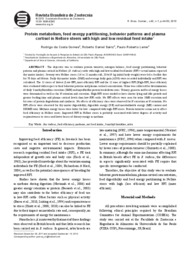Protein metabolism, feed energy partitioning, behavior patterns and plasma cortisol in Nellore steers with high and low residual feed intake.
Protein metabolism, feed energy partitioning, behavior patterns and plasma cortisol in Nellore steers with high and low residual feed intake.
Author(s): GOMES, R. da C.; SAINZ, R. D.; LEME, P. R.
Summary: The objective was to evaluate protein turnover, nitrogen balance, feed energy partitioning, behavior patterns and plasma cortisol in Nellore (B. indicus) cattle with high and low residual feed intake (RFI = actual minus expected dry matter intake). Seventy-two Nellore steers (16 to 21 months-old, 334±19 kg initial body weight) were fed a feedlot diet for 70 days ad libitum. Daily dry matter intake (DMI) and average daily gain (ADG) were recorded individually and RFI was calculated. The 12 steers of lowest (Low-RFI, most efficient) RFI and the 12 ones of highest RFI (High-RFI, least efficient) were evaluated with respect to their behavior patterns and plasma cortisol concentration. Urine was collected for determination of daily 3-methylhistidine excretion (3MH) and myofibrillar protein breakdown rates. Urinary, gaseous and fecal energy losses were determined as well as the N retention and excretion. High-RFI steers tended to have shorter lying and idle periods and greater feeding time and plasma cortisol levels than low-RFI cattle. No RFI effects were seen for urine 3MH excretion and for rates of protein degradation and synthesis. No effects of efficiency class were observed for N excretion or N retention. No RFI effects were observed for dry matter digestibility, digestible energy (DE) and metabolizable energy (ME) content and DE/ME ratio. Methane energy losses were lower for low- compared with high-RFI steers. Protein turnover seems not to affect feed efficiency in Nellore steers. Improved RFI in Nellore steers is probably associated with lower degrees of activity and responsiveness to stress and lower losses of dietary energy as methane.
Publication year: 2013
Types of publication: Journal article
Unit: Embrapa Beef Cattle
Keywords: Bovino de corte, Nutrição Animal
Observation
Some of Embrapa's publications are published as ePub files. To read them, use or download one of the following free software options to your computer or mobile device. Android: Google Play Books; IOS: iBooks; Windows and Linux: Calibre.
Access other publications
Access the Agricultural Research Database (BDPA) to consult Embrapa's full library collection and records.
Visit Embrapa Bookstore to purchase books and other publications sold by Embrapa.

